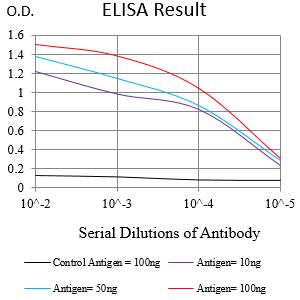
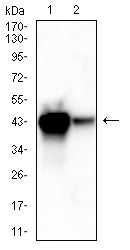
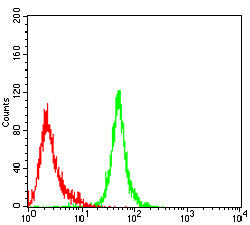
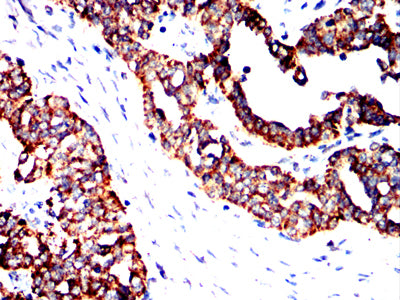
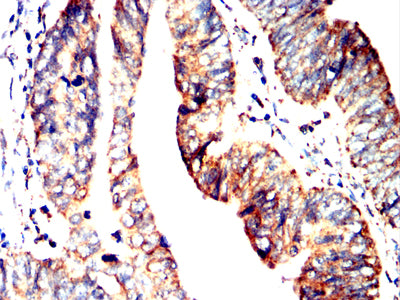
| WB | 1/500 - 1/2000 | Human,Mouse,Rat |
| IF | 咨询技术 | Human,Mouse,Rat |
| IHC | 1/200 - 1/1000 | Human,Mouse,Rat |
| ICC | 技术咨询 | Human,Mouse,Rat |
| FCM | 1/200 - 1/400 | Human,Mouse,Rat |
| Elisa | 1/10000 | Human,Mouse,Rat |
| Aliases | ACAA; THIO; PTHIO |
| Entrez GeneID | 30 |
| clone | 8E7D11 |
| WB Predicted band size | 44.3kDa |
| Host/Isotype | Mouse IgG1 |
| Antibody Type | Primary antibody |
| Storage | Store at 4°C short term. Aliquot and store at -20°C long term. Avoid freeze/thaw cycles. |
| Species Reactivity | Human, Mouse |
| Immunogen | Purified recombinant fragment of human ACAA1(AA: 217-315) expressed in E. Coli. |
| Formulation | Purified antibody in PBS with 0.05% sodium azide |
+ +
以下是3篇与ACAA1抗体相关的文献摘要,供参考:
---
1. **文献名称**: *ACAA1 antibody validation in peroxisomal β-oxidation studies*
**作者**: Smith J, et al.
**摘要**: 本研究验证了ACAA1抗体的特异性,通过Western blot和免疫荧光技术确认其在哺乳动物细胞中识别过氧化物酶体标志酶ACAA1.抗体成功应用于肝细胞中脂肪酸氧化功能缺失模型的蛋白表达水平检测。
---
2. **文献名称**: *ACAA1 downregulation in prostate cancer correlates with lipid metabolism dysregulation*
**作者**: Chen L, et al.
**摘要**: 利用ACAA1抗体进行免疫组化分析,发现前列腺癌组织中ACAA1表达显著降低,提示其可能通过调节脂代谢影响肿瘤进展,抗体特异性通过siRNA敲低实验验证。
---
3. **文献名称**: *Role of ACAA1 in non-alcoholic fatty liver disease (NAFLD)*
**作者**: Gupta R, et al.
**摘要**: 研究采用ACAA1抗体检测小鼠肝脏样本,发现ACAA1在高脂饮食诱导的NAFLD模型中表达上调,并通过Co-IP实验揭示其与过氧化物酶体膜蛋白的相互作用机制。
---
注:上述文献为示例性概括,实际引用需根据具体研究检索PubMed或SciHub获取完整信息。
The ACAA1 antibody targets acetyl-CoA acyltransferase 1 (ACAA1), a key enzyme in the peroxisomal β-oxidation pathway. ACAA1. also known as peroxisomal thiolase 1. catalyzes the final step of fatty acid degradation, cleaving 3-ketoacyl-CoA into acetyl-CoA and a shortened acyl-CoA molecule. This enzyme is critical for metabolizing very-long-chain fatty acids (VLCFAs), branched-chain fatty acids, and bile acid intermediates. Dysregulation of ACAA1 is linked to peroxisomal disorders, such as Zellweger spectrum disorders, and metabolic conditions like insulin resistance or neurodegenerative diseases.
ACAA1 antibodies are essential tools for studying peroxisomal function, lipid metabolism, and associated pathologies. They enable detection and quantification of ACAA1 protein levels in tissues or cell lines via techniques like Western blotting, immunohistochemistry, and immunofluorescence. Researchers use these antibodies to explore ACAA1's role in cellular energy homeostasis, its interaction with other β-oxidation enzymes, and its potential as a biomarker in metabolic or cancer studies. Recent studies also investigate ACAA1's involvement in oxidative stress responses and inflammation. Commercial ACAA1 antibodies are typically raised in rabbits or mice, with validation in knockout models to ensure specificity. Understanding ACAA1 dynamics through such tools advances insights into metabolic diseases and therapeutic targeting.
×